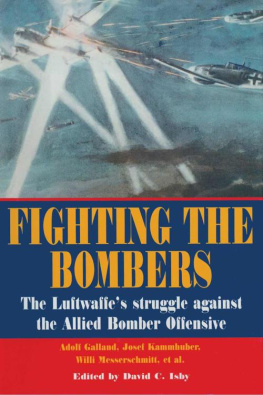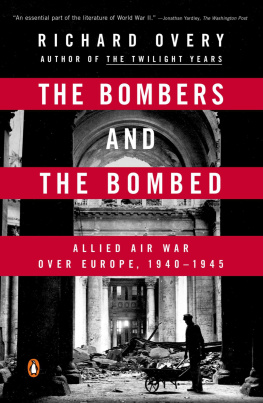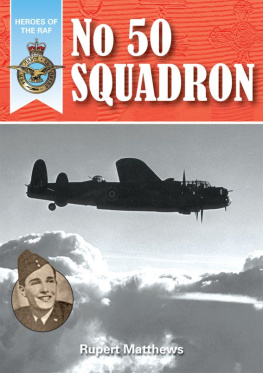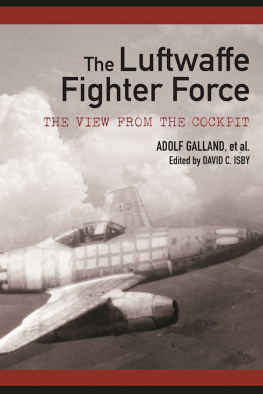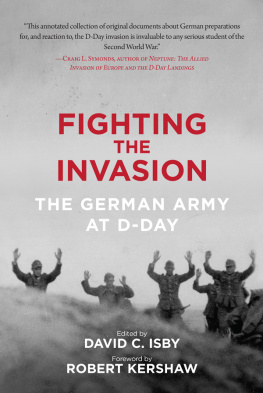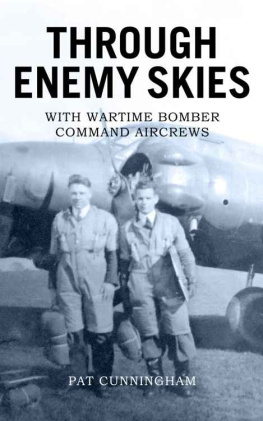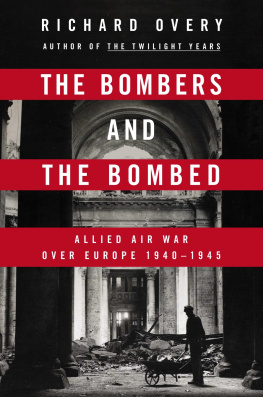

FIGHTING THE
BOMBERS
FIGHTING THE
BOMBERS
The Luftwaffes Struggle
Against the Allied Bomber Offensive
AS SEEN BY ITS COMMANDERS
by
General der Flieger Josef Kammhuber, Generalleutnant Josef Beppo Schmid, Generalmajor Hans-Detlef Herhuth von Rohden, Dr. Willi Messerschmitt, Generalleutnant Adolf Galland, Generaloberst Hubert Weise, General der Flieger Wolfgang Martini, Major Heinz-Wolfgang Schnaufer, Major Heinrich Ruppel, Major G. S. Sandmann, Major Josef Scholls
Edited by
David C. Isby

Frontline Books

Fighting the Bombers:
The Luftwaffes Struggle against the Allied Bomber Offensive
First published 2003 by
Greenhill Books
published in this format in 2015 by
Frontline Books,
an imprint of
Pen & Sword Books Ltd
47 Church Street, Barnsley, S70 2AS
www.frontline-books.com
Copyright David C. Isby
All rights reserved. No part of this publication may be
reproduced, stored in a retrieval system or transmitted in any
form or by any means, electronic, mechanical or otherwise,
without the written permission of the Publisher.
British Library Cataloguing in Publication Data
Fighting the bombers:
the Luftwaffes struggle against the Allied bomber offensive
1. Germany. Luftwaffe Drill and tactics 2. World War,
19391945 Aerial operations, British 3. World War,
19391945 Aerial operations, American
4. Bombing, Aerial Germany
I. Kammhuber, Josef II. Isby, David C.
940.5'44941
ISBN 1-85367-532-6
Library of Congress Cataloging-in-Publication Data available
Designed and typeset by Roger Chesneau
Printed and bound in Great Britain
Contents
compiled by Generalmajor Hans-Detlef Herhuth von Rohden, August 1946 by Generaloberst Hubert Weise by General der Flieger Josef Kammhuber by Generalmajor Hans-Detlef von Rohden by Generalleutnant Josef Beppo Schmid by Generalleutnant Josef Beppo Schmid : Interrogation of Generalleutnant Adolf Galland 15 October 1945 : Interrogation of General der Flieger Wolfgang Martini 10 October 1945 : Interrogation of OKL Staff
: Development, Experience, Success, and Prospects by Dr Willi Messerschmitt
: Interrogation of General der Flieger Josef Kammhuber 4, 22, 28 August 1945
by Major Heinrich Ruppel
: Interrogation of Major G. S. Sandmann 16 August 1945
: Interrogation of Major G. S. Sandmann 1 August 1945
: Interrogation of Major Heinz-Wolfgang Schnaufer (and two NJG 4 Gruppenkommandeure) 21 May 1945
by Major Josef Scholls
: Interrogation of Major Josef Scholls 16 August 1945
: Interrogation of Major Heinrich Ruppel
by Generalmajor Hans-Detlef Herhuth von Rohden
This book is a collection of Luftwaffe leaders views of the Defense of the Reich against the Allied combined bomber offensive. The accounts give their version of the course of the battle against the bombers, how technology was developed and deployedor notin the increasingly sophisticated operations, and how the technology was employed in combat by fighter leaders and controllers. The longest and largest air campaign in history has certainly attracted its share of historians. However, the German accounts provided here give some unique insights.
The authors compiled most of these documents as prisoners of war, under the authority of the US Army Air Forces (although some of the interrogations on nightfighting were conducted by RAF specialists, themselves veterans of the bomber offensive). These documents represent the command debrief of many of the Luftwaffes leaders, undertaken in 1945 or 1946. It is to our advantage that these debriefs were carried out while memories were fresh, for the prisoners were without most official documents. The exceptions were the von Rohden and Messerchmitt chapters, which were historical narratives requested by the USAAF and US Navy, respectively. These accounts are written by professionals, for other professionals. Much of the syntax and capitalization is non-standard and reflects that of the German original. The authors assume that those for whom they are writing know the abbreviations, equipment, and references they use freely (which has required the provision of a glossary).
The accounts include matters often overlooked, such as the development of German fighter control capabilities and tactics. They are, quite literally, the first draft of the history of the Luftwaffe fighter force, and make up in immediacy what they may lack in reflection and opportunities for archival research. Each of the authors was interrogated on subjects about which he had direct personal knowledge: the intense internal secrecy of the German war effort makes claims to knowledge that did not come from such hands-on experience suspect.
These accounts are earlier and less refined than the better-known series of historical studies written by former Luftwaffe officers (some volumes of which have been reprinted by publishers such as Greenhill Books and Garland) and collectively referred to as the Karlshrue Studies. However, the chapters by von Rohdenwho went on to manage the Karlshrue Studiesmay be seen as being the first of the series of studies. These chapters written done as a collaborative effort with a number of other Luftwaffe officers, including at least two of the authors of this volume, Adolf Galland and Beppo Schmid.
This book is in many ways complementary to The Luftwaffe Fighter Force: The View From the Cockpit, published by Greenhill in 1998. That was the history of an air forcethat part of the Luftwaffe which flew fightersfrom organization to ultimate defeat; Fighting the Bombers is the story of that forces greatest battle. Thus, it begins with historical narratives (those of von Rohden, Weise and Kammhuber) to set out the overall context. Then the technologies involved are introduced in more detail. Finally, there is consideration of the manner in which these technologies were applied by the fighter controllers and fighter pilots involved in the Defense of the Reich. Fighting the Bombers also stresses the technology of radio and radar and the night battle whereas the earlier book put more emphasis on covering the daylight battles. This reflected the role of Adolf Gallandwhose concern was daylight air fightingas the unifying voice in that book. In this book, although Galland reappears, there is a greater range of authors and concerns. The current volume could be subtitled The View From the Ops Room, because that is where the authors did most of their fighting, leading and directing the fighters. While this volumes contributors include Major Schnaufer, the highest-scoring nightfighter ace (with 121 victories), the emphasis is on the system itself rather than the pilots who were at its sharp end.
The narratives are all highly personal to the authors and certainly do not represent a more nuanced view taking a broader range of sources into account; some of the authorsmost notably Kammhuber and Schmidtook this wider view in the 1950s when they prepared volumes in the Karlshrue studies. Others, like Schnaufer (killed in a post-war accident), never got to tell their story again. There has been no attempt to correct the accounts, even where the authors get things wrong, or to insert more recent or superior knowledge. Whenever possible, the original spellings and terminology have been maintained, including even such elementary things as capitalization and the rendering of umlauts into English, which have been placed without consistency in the original documents. The translation has been edited to bring specific terminology, but not necessarily grammar and syntax, into line with standard English-language usage. But the alterations have been kept to a minimum.
Next page
